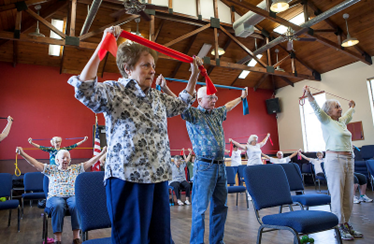
Strength training
Muscle mass and bone density decline with age, and strength training has a positive effect on maintaining the level of muscle mass and bone density late into old age. Strength training also has a significant positive impact on walking and maintaining balance. Before strength exercises, we warm up with aerobic activity and dynamic stretching exercises. When training for strength, it is important to include all major muscle groups – leg muscles, back muscles, abdominal muscles, chest muscles, hip muscles, arm muscles and shoulder girdle muscles.
Exercises can be performed with your own weight or with the help of accessories such as weights, elastic bands, a big ball, pilates ball, fitness equipment, outdoor fitness equipment… We choose 6 to 8 exercises. We perform 1-3 sets, with 10-15 repetitions of each exercise. Exercises are performed slowly and in a controlled manner. We must pay attention to the correct execution of the exercises. We do not exaggerate the difficulty of the exercises.

SOURCE?
At the beginning, we perform the exercises with lighter weights, choose a smaller number of exercises and do fewer series and repetitions, then gradually increase the difficulty, but only when we have already mastered the correct execution of the exercises. The difficulty of the exercise can be increased by increasing the weight of the weights, the number of sets, the number of repetitions and the frequency of the exercise. For elderly people who have mobility problems, strength training can also be done with functional exercises, such as getting up from a chair, walking up stairs, etc.
Effects that occur as a result of regular strength training: improvement of muscle strength and power, improvement of muscle quality, improvement of muscle endurance, increase in the proportion of lean body mass, decrease in the proportion of fat mass, maintenance or increase in bone mineral density.


